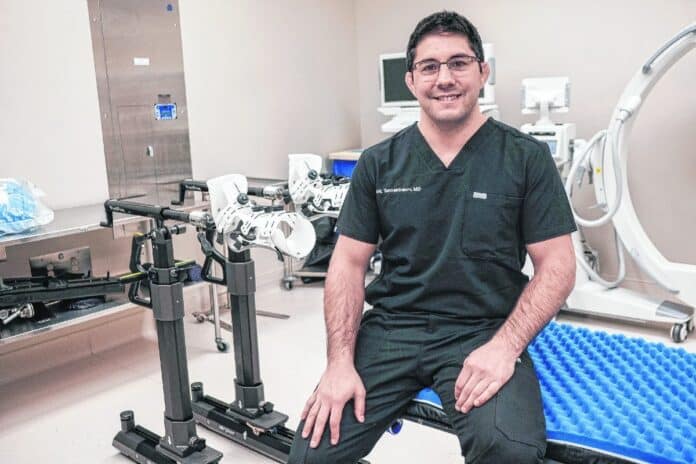
The pain had gotten so bad in Philip Artis’ right hip that he could do little other than lie down at the end of workday at his manufacturing job. He rated the discomfort most days as an eight on a scale of 1 to 10. Even though he was only 18 at the time of one medical exam, one doctor told him he probably would need a hip replacement by age 25.
But in early November, the Columbus resident replaced those plans with a different, less radical procedure — one that saved his hip, saved him a possible journey through narcotics and saved him plenty of post-surgical struggle.
He found Columbus’ Dr. Eric Tannenbaum, a Southern Indiana Orthopedics surgeon who suggested a newer version of a minimally-invasive hip preservation procedure, also known as hip arthroscopy. Tannenbaum is among a small number of doctors in central Indiana, and the only one in the Columbus area, doing the surgery.
But, until recently, some of the traditional hip arthroscopy surgeries left patients with groin injuries. Tannenbaum’s approach avoids that by skipping an old element of a perineal post being placed on the groin to get proper access to an injured hip.
[sc:text-divider text-divider-title=”Story continues below gallery” ]
In Tannenbaum’s procedure, a Stryker Pivot Guardian tilted bed, designed to minimize post-procedure complications, provides proper traction and patient positioning during the surgery.
“My quality of life has increased so much,” Artis said. “Now, after work, I can get things done around the house.”
Before the procedure in November, “just going up the steps to my upstairs apartment was a struggle,” he said. “Now, I can just go right up them. And before, just to step my foot over the edge of the bathtub to get in the shower was very painful.
“Now, I can do that easily.”
His pain level most days after work is only a “one” or a “two” now — a dramatic change. And he said that’s simply because he still is recovering and rebuilding strength in the hip that was the focus of the procedure, according to his physical therapist.
“The fact that this helped me so much has motivated me to see if I can help others get the same help,” Artis said.
An especially strong and healthy mobility matters perhaps a bit more to Artis than some others since he is in the Marine Reserves. And his increasing ease of movement is all the more dramatic since he broke his pelvis in three places in an auto accident a year ago, besides his hip challenges.
Tannenbaum strongly feels that the newer hip arthroscopy procedure needs more public attention — especially when he has seen patients who were told several years ago that they would have to learn to deal with their hip pain until time for a hip replacement. They were told nothing else could be done.
The newer procedure corrects a situation before added problems develop, according to the surgeon. So he’s now doing all he can to get the word out. He began doing the surgery locally in September. In his training in Los Angeles, he spent an entire year doing hip preservation and other procedures from world-renowned leaders in the field.
“My biggest hope down the road is to just get busier doing these (procedures) to help people,” Tannenbaum said.
[sc:pullout-title pullout-title=”About the doctor and procedure” ][sc:pullout-text-begin]
Who: Dr. Eric Tannenbaum of Columbus’ Southern Indiana Orthopedics (not related to Dr. Darryl Tannenbaum in the same practice).
Specialty procedure: Newer hip arthroscopy that addresses a wide range of chronic hip pain and avoids post-surgical groin-related problems of the past and is a less-dramatic procedure than a hip replacement.
Recovery time: About three months, depending upon a mix of variables and physical therapy.
[sc:pullout-text-end]




